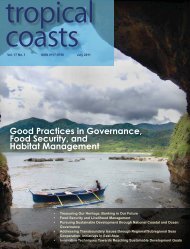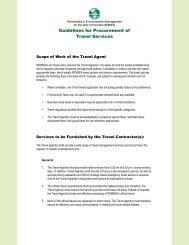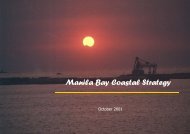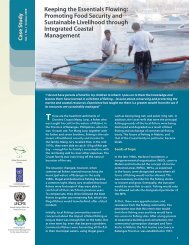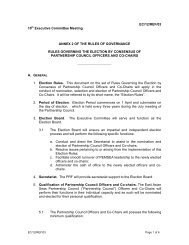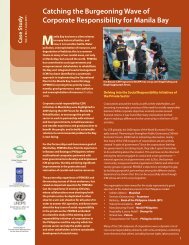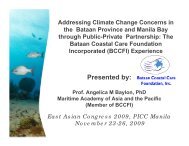Download PDF Copy - Pemsea
Download PDF Copy - Pemsea
Download PDF Copy - Pemsea
You also want an ePaper? Increase the reach of your titles
YUMPU automatically turns print PDFs into web optimized ePapers that Google loves.
S U S T A I N A B L E D E V E L O P M E N T A S P E C T S<br />
Implications and Recommendations<br />
Marine scientists estimate that roughly 10–30 percent<br />
of each habitat must be fully protected to help sustain<br />
ecosystem functions and services. Moreover, Republic Act<br />
8550 (Philippine Fisheries Code), recommends that at least<br />
15 percent of municipal waters and 25 percent of mangroves<br />
be protected. While the above recommendations are to be<br />
applied per habitat type, in the past, coral reefs have been<br />
given more attention in the establishment and study of MPAs.<br />
Simulation studies of coral reef protected areas in Mabini<br />
and Verde Island based upon current fishing intensity and<br />
condition of fish stocks (MERF/UP/CI-Philippines, 2007)<br />
indicate that larger total areas of fully-protected MPAs and<br />
lower intensity of fishing is needed to sustain reef fish stocks.<br />
Specifically, at least 53 percent and 73 percent of coral reefs<br />
in Mabini and Tingloy, respectively, are recommended for<br />
full protection. Although some individual MPAs in Batangas<br />
are well managed, total marine area protected in Batangas<br />
is only about 7 percent of municipal waters, of which only a<br />
much smaller portion (0.1 percent of municipal waters) is fully<br />
protected from extractive and pollutive activities.<br />
Roughly 10–30 percent of each habitat must be fully<br />
protected to help sustain ecosystem functions<br />
and services.<br />
Moreover, based upon: a) economies of scale with respect<br />
to MPA management and enforcement patrolling costs; and<br />
b) ease of movement of fish between core and fishing areas,<br />
current sizes of fully protected or “no-take” MPAs (core<br />
areas) are quite small. The Philippine MPA Support Network<br />
currently advocates that core areas be no smaller than 20 to<br />
30 ha with at least 50 ha preferred.<br />
The Batangas Province SEMP already includes plans for the<br />
establishment and strengthening of a network of protected<br />
areas. It is thus recommended that the Batangas MPA<br />
Network consider the above recommended minimum sizes<br />
when setting targets for implementation.<br />
Available technical guidelines for terrestrial and cultural<br />
protection must also be considered in setting targets for<br />
those other protected areas.<br />
Habitat Protection, Restoration and Management<br />
Protected areas for coastal habitats and heritage<br />
References<br />
Bautista, G. 2007. The Archeology of Calatagan, Batangas: An Evaluation for the Institution of a Cultural Resource<br />
Management Programme in the Locality.<br />
Marine Environment and Resources Foundation (MERF), University of the Philippines (UP), Conservation International-<br />
Philippines (CI-Philippines). 2007. Completing the Connectivity Cycle for Adaptive Management: Coral Reef<br />
Ecosystem-based MPA Network Management Chain.<br />
Mendoza, Noel. BCRMF Coordinator. Personal Communication. March 2008.<br />
Morales, Luningning. DENR-PENRO. Personal Communication. October 2007.<br />
WWF-Philippines. 2007. Marine Protected Areas in Batangas. Presented during the Joint BBREPC-PSWMB Meeting<br />
in November 2007.<br />
State of the Coasts of Batangas Province<br />
73



